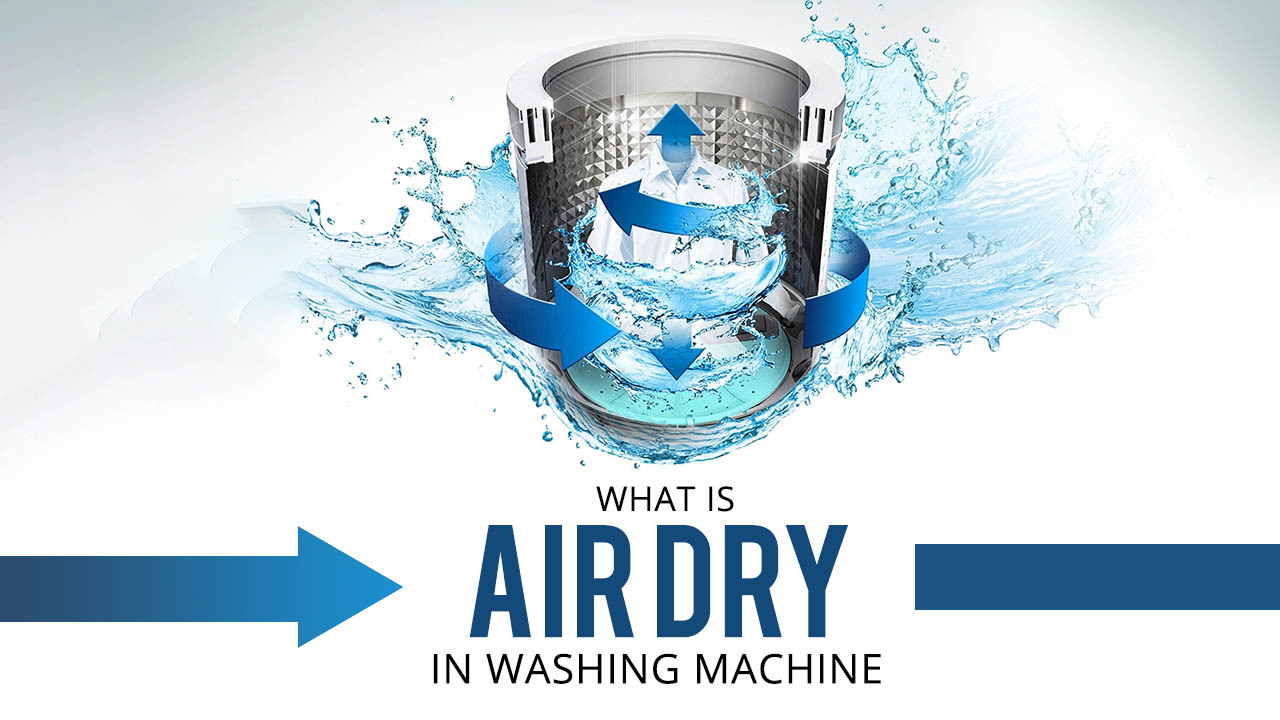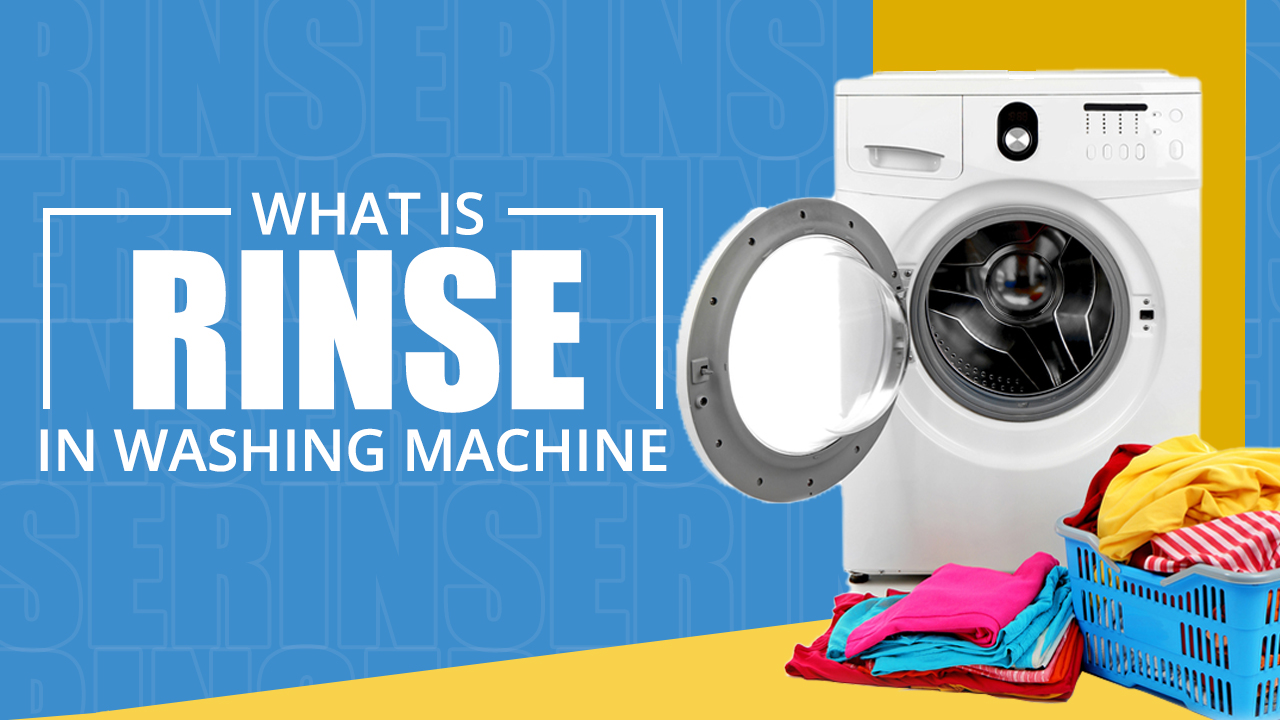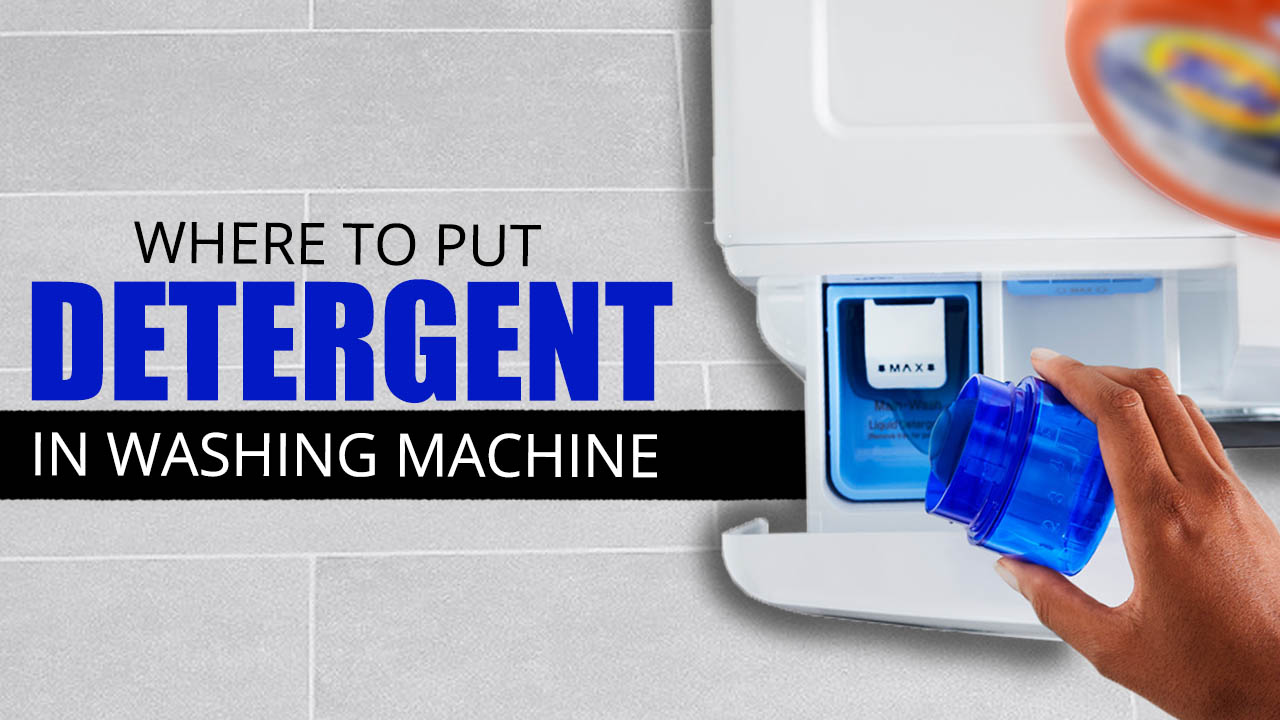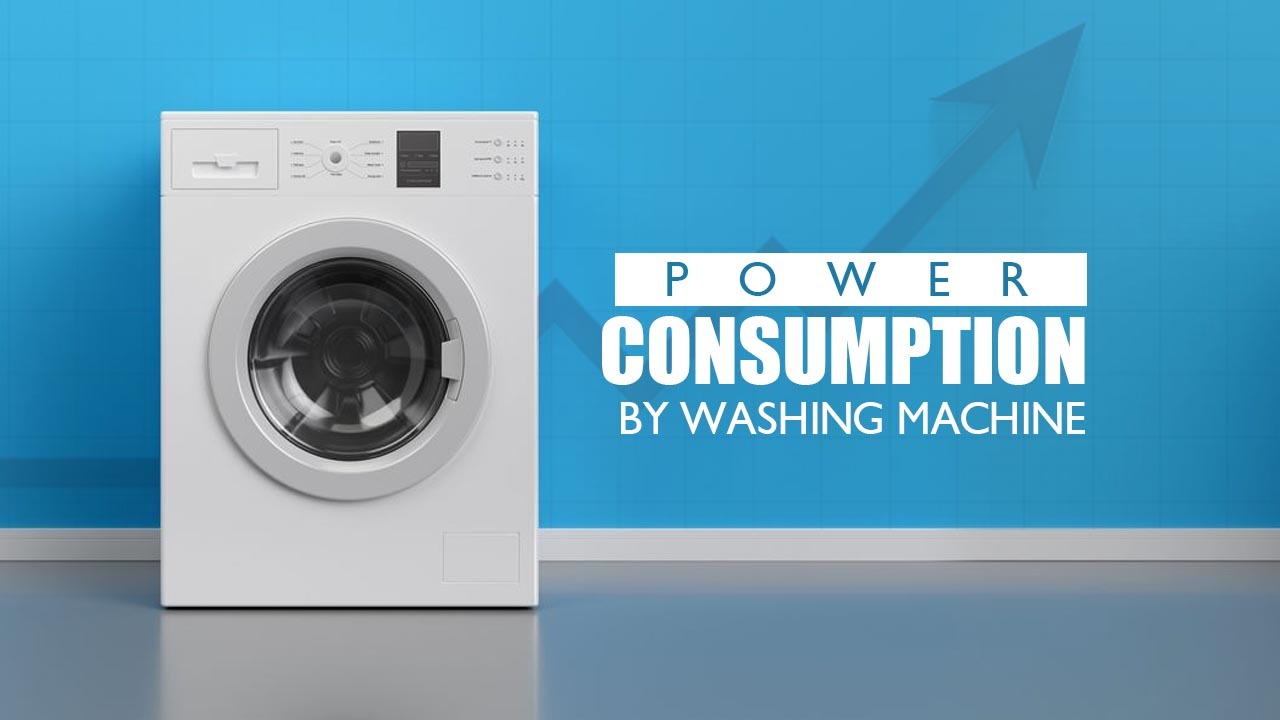When it comes to washing clothes, a washing machine is literally one of the best appliances you can get for yourself. You can go ahead and wash it by hand, spending your precious time and energy on it, or you can get a basic or the best washing machine that not only washes your clothes for you.
The convenience a washing machine provides is simply exceptional. That said, when it comes to drying clothes, there are two methods washing machines generally use, spin method and air drying. So, what is air dry in washing machine? A simple technology that uses air and a fast rotating drum to remove all moisture from your clothes in a matter of seconds.
Let us take a look at what is air dry in washing machines to get a better idea, and its advantages and disadvantages.
What is Air Dry in Washing Machine
Air Dry refers to a specific function or feature available in certain washing machines that aids in the drying process of laundry. The Air Dry mode does not use heat like a traditional dryer but instead utilizes natural air circulation to remove moisture from clothes. While the exact implementation may vary across different washing machine models, the general concept remains consistent.
When the Air Dry mode is activated, the washing machine draws air into the chamber through vents located within the tub and lid. The machine then goes through a spinning process, similar to a regular wash cycle, while circulating the air within the drum. This spinning action helps to remove excess water from the clothes, preparing them for the drying phase.
Unlike a dryer that employs heat to evaporate moisture, the Air Dry function relies on natural air movement to aid in the drying process. The air drawn into the washing machine is typically at room temperature or slightly warm, depending on the specific model. Some washing machines may incorporate a fan or other mechanisms to enhance air circulation around the clothes, facilitating the drying process.
It is important to note that while the Air Dry mode helps to remove moisture from clothes, it may not dry them as thoroughly as a dedicated dryer. The primary purpose of this feature is to minimize moisture content in the clothes, allowing for easier and quicker subsequent drying, either through air drying or using a dryer.
Advantages and Disadvantages of the Air Dry Mode
The air dry mode in a washing machine provides distinct advantages and disadvantages that should be taken into account when deciding how to dry your clothes. Understanding these factors can help you make an informed decision based on your preferences and needs.
| Advantages | Disadvantages |
|---|---|
| Time and Energy Savings: The air dry mode can save time and energy by reducing the drying time of clothes compared to traditional air drying methods. It can be especially useful when you need your clothes to dry quickly. | Moisture Retention: While the air dry mode removes most of the moisture from clothes, it may not be as effective as using a dryer in completely eliminating moisture. This can result in slightly damp clothes that may require additional air drying or ironing before being ready to wear. |
| Convenience: Air dry mode eliminates the need to wait for clothes to dry on a clothesline, offering a more convenient option for drying laundry. | Longer Drying Time: Air dry mode typically takes longer to dry clothes compared to machine drying. It relies on natural air circulation and may require several hours or even a full day to fully dry garments, depending on factors like humidity, temperature, and airflow. |
| Gentle Drying: Air dry mode is generally considered gentler on clothes compared to machine drying. It helps prevent shrinkage, fading, and damage caused by high heat or mechanical agitation in a dryer. | Potential Wrinkling: Air-dried clothes may have more wrinkles compared to those dried in a dryer. Proper folding or ironing may be required to remove wrinkles before wearing the clothes. |
| Environmental Benefits: Utilizing the air dry mode in washing machines can contribute to environmental sustainability by reducing energy consumption and carbon emissions associated with machine drying. | Dependent on Air Circulation: The effectiveness of the air dry mode in washing machines is dependent on the air circulation within the machine itself. If the air vents or inlets are obstructed, it may hinder the drying process and result in less efficient drying. |
It’s important to note that the advantages and disadvantages mentioned above can vary depending on the specific washing machine model and brand. It is recommended to refer to the user manual or manufacturer’s instructions for detailed information on the air dry mode of a specific washing machine model.
How Does the Air Dry Mode Work
Air dry mode in a washing machine refers to a specific function or cycle designed to dry clothes without using heat or relying on a traditional dryer. Instead, it utilizes natural air circulation to remove excess moisture from the garments. Here’s a comprehensive explanation of air dry mode in washing machines:
This mode works by drawing in natural air through vents within the washing machine drum during the spin cycle. As the drum rotates, excess water is wrung out from the clothes, and the warm air from the surroundings circulates within the machine, aiding in the drying process. Some washing machine models may even incorporate a heater, such as a 300W heater, to maintain an internal temperature of approximately 55°C, further assisting in drying the laundry.
It’s important to note that air dry mode does not use heat in the same way as a dryer does, making it a more energy-efficient option. The air dry cycle helps to remove most of the moisture remaining in the clothes, providing a similar drying effect to that of a front-loading washing machine.
To use the air dry function in washing machine, you can follow the steps below:
- Once the spin cycle of your washing machine is complete, distribute your clothes evenly and ensure they are not tangled. Close the lid of the washing machine before proceeding.
- Look for the air dry function on the control panel of your washing machine. It may be labeled as “Air Dry” or represented by a symbol that looks like a fan. If there are specific temperature settings for the air dry function, choose the appropriate one for your fabrics.
- Press the start button or follow the instructions on the control panel to initiate the air dry cycle. The washing machine will begin to circulate air through the drum to dry the clothes.
- If your washing machine allows you to adjust the duration of the air dry cycle, set it according to your preferences or the specific needs of your clothes. Follow the instructions provided in the user manual or on the control panel to make the necessary adjustments.
- Allow the washing machine to complete the air dry cycle. The duration of the cycle may vary depending on the specific washing machine model and the amount of moisture in the clothes.
- Once the air dry cycle is finished, open the washing machine and carefully remove the dry clothes. Fold or hang them as desired.
Which Fabrics Should You Air Dry
Here’s a selection of fabrics that should be air-dried, ensuring that your garments remain in excellent condition for years to come.
- Acrylic: Acrylic is a synthetic fiber known for its softness, lightweight feel, and ability to retain color well. When it comes to drying, it is recommended to air-dry acrylic garments to prevent shrinking and stretching. Simply lay them flat on a clean, dry surface, and allow them to dry naturally.
- Cotton: Cotton, one of the most commonly used natural fibers, is generally safe for machine drying. However, to avoid potential shrinkage and maintain the fabric’s longevity, it is advisable to air-dry certain cotton items, such as delicate clothing or those with embellishments. Hang them on a clothesline or drying rack away from direct sunlight to prevent fading.
- Denim: Denim is a sturdy and durable fabric often used in jeans and jackets. While it can be dried in a machine, air-drying denim helps maintain its shape and prevents excessive wear. Turn denim garments inside out to preserve color and hang them up to dry. Avoid using clothespins, as they can create unwanted creases.
- Linen: Linen, a natural fabric derived from flax plants, is highly breathable and lightweight. Although linen can be tumble dried on low heat, air-drying is preferred to minimize the risk of wrinkling and shrinkage. Hang linen garments or lay them flat to dry, allowing the breeze to help achieve a crisp finish.
- Microfiber: Microfiber fabrics are popular for their softness, durability, and ability to wick away moisture. When it comes to drying microfiber items, it is best to air-dry them to maintain their quality. Lay them flat or hang them up, ensuring proper ventilation, and they will dry quickly.
- Nylon: Nylon, a synthetic fabric known for its strength and elasticity, is often found in sportswear, swimwear, and hosiery. While nylon can withstand the heat of a dryer, air-drying is recommended to prevent potential damage, such as stretching or shrinking. Simply hang nylon garments or lay them flat to dry.
- Polyester: Polyester is a widely used synthetic fabric known for its durability, wrinkle resistance, and quick-drying properties. While polyester can be safely dried in a machine, air-drying certain delicate items, such as lingerie or clothing with delicate trims, is a preferable option to maintain their shape and extend their lifespan.
Which Fabrics Should You Not Air Dry
While air-drying is often considered a gentle and energy-efficient method of drying clothes, there are certain fabrics that require alternative care. Air-drying these fabrics could lead to shrinkage, distortion, or other forms of damage.
- Cashmere: Cashmere is a luxurious and delicate fabric known for its softness and warmth. However, it is highly susceptible to damage from improper drying techniques. Air-drying cashmere can cause the fibers to become misshapen or stretched out. To preserve the quality of your cashmere items, it is recommended to lay them flat on a clean towel to dry.
- Lace: Lace garments add an elegant touch to any wardrobe, but their intricate designs require special care. When air-dried, lace can lose its shape and become stretched or distorted. Instead, lay your lace items flat on a towel or place them on a padded hanger to dry, ensuring that the weight of the garment is evenly distributed.
- Leather & Suede: Leather and suede are unique materials that require specific cleaning and drying methods. Air-drying these fabrics can cause them to become stiff, lose their softness, or even develop a musty smell. It is best to use a specialized leather or suede conditioner and follow the manufacturer’s instructions for drying. Hanging them on a sturdy hanger in a well-ventilated area is often recommended.
- Rayon: Rayon is a versatile fabric that mimics the appearance of silk, cotton, or wool. However, it is prone to shrinking or losing its shape when exposed to moisture. Instead of air-drying rayon, consider using a low heat setting on your dryer or laying the garment flat to dry.
- Silk: Silk is a delicate and luxurious fabric known for its smooth texture and lustrous appearance. Air-drying silk can cause it to become stiff, wrinkled, or lose its natural sheen. To retain the softness and elegance of silk garments, carefully hand-wash them and then gently roll them in a clean towel to remove excess moisture before laying them flat to dry.
- Spandex: Spandex is a stretchy fabric commonly used in athletic wear and form-fitting clothing. Air-drying spandex garments can lead to loss of elasticity and shape. To maintain the stretch and shape of spandex, it is best to tumble dry on a low heat setting or follow the manufacturer’s instructions.
- Wool: Wool is a natural fiber prized for its warmth and durability. However, air-drying wool can cause it to shrink or lose its shape. To prevent damage, gently squeeze out excess water from wool garments and reshape them while they are still damp. Lay them flat on a clean towel or a drying rack to maintain their original form.
How Long Does Air Drying Take
Determining the exact duration of the air drying cycle can be challenging due to various factors that can influence drying time. However, are some insights into the expected timeframe:
The air drying cycle, also known as the air fluff cycle, typically does not involve the use of heat. As a result, the drying time can be longer compared to cycles with heat. The specific duration of the air drying cycle can vary depending on factors such as
- Fabric type
- Air temperature
- Humidity
- Airflow
The estimated time for air drying clothes can range from 45 minutes to 24 hours. However, it’s important to note that these are general estimates and actual drying times may vary significantly based on the aforementioned factors.
Factors like fabric type and drying environment play a significant role in determining the drying time. Fabrics with higher absorbency or thickness may take longer to dry compared to lighter fabrics. Additionally, outdoor drying times can be influenced by weather conditions, such as wind and sunlight.
It’s worth noting that the air drying cycle duration may also vary based on the specific settings and capabilities of the dryer being used. For instance, some dryers may have default air drying cycle times around 30 minutes, which can be adjusted as needed.
How to Properly Use the Air Dry Mode in Your Washing Machine
Doing laundry is not always an easy task, especially when it comes to drying your clothes, bed sheets, and towels. Thankfully, many modern washing machines come equipped with an air dry mode that can help you save time and money. This mode allows you to dry your clothes using air circulation rather than heat, which can reduce the risk of shrinking or damaging your fabrics. Below, we will provide you helpful tips and step-by-step instructions on how to use the air dry mode in your washing machine.
- Prepare Your Washing Machine: Before you start using the air dry mode, make sure your washing machine is in good working condition. Check the power supply and make sure that your washing machine is connected to an outlet. Remove any clothes or water from the machine, as the air dry mode works best when the drum is empty.
- Select the Air Dry Program: Once you have ensured that your washing machine is ready, select the air dry program on the control panel. Look for the icon of clothes hanging on a hanger or the words “air dry” on the display. Some washing machines may also have different settings, so refer to the user manual to locate the air dry mode.
- Initiate the Drying Cycle: Once you have located the air dry program on your washing machine, press start to initiate the drying cycle. The washing machine will start rotating the drum and circulating air inside the machine. The duration of the drying cycle may vary depending on the model of your washing machine, so check the user manual for an estimated drying time.
- Check for Additional Features: Some washing machine models may have additional features to enhance the air drying process. These features may include drawing in warm air or maintaining a specific internal temperature to help dry your clothes faster. Check the user manual or instructions provided by the manufacturer for your specific washing machine model to ensure optimal usage and results.
- Let the Cycle Complete: Once your washing machine has finished the air dry cycle, open the door and take out your dry clothes. Always make sure to turn off your washing machine and unplug it from the power source when not in use.
Using the air dry mode in your washing machine can save a lot of time and energy while still achieving dry, clean clothes. However, it is important to remember that every washing machine and drying cycle is unique and may require different settings. Following the steps mentioned above will help you properly use the air dry mode, but make sure to consult your user manual for additional information. With the right usage and maintenance of your washing machine, your clothes will remain in excellent condition and look as good as new.
Air Drying vs Tumble Drying
Air drying and tumble drying are two common methods of drying clothes after washing. Each method has its advantages and considerations, and understanding the differences between them can help you choose the most suitable option for your needs.
| Aspect | Air Drying | Tumble Drying |
|---|---|---|
| Drying Mechanism | Air drying involves the natural circulation of air to dry clothes. It typically relies on ambient air or ventilation to evaporate moisture from the clothes. Some washing machines offer an “Air Dry” or similar option that utilizes the machine’s natural air circulation to dry the clothes without heated air. | Tumble drying utilizes a combination of heated air and mechanical action. In this method, wet clothes are placed in the machine’s drum, which rotates and tumbles the clothes while hot air circulates through the drum. The heated air accelerates the evaporation of moisture, resulting in faster drying times compared to air drying methods. |
| Drying Time | Air drying is generally slower compared to tumble drying. Since it relies on natural air circulation, the drying time can vary depending on environmental conditions such as temperature, humidity, and airflow. Air drying can take several hours or even a full day to completely dry the clothes. | Tumble drying is typically faster than air drying due to the combination of mechanical action and heated air. The rotation of the drum and the introduction of hot air facilitate faster evaporation of moisture, resulting in shorter drying times. Tumble drying can complete the drying process in a matter of minutes to a couple of hours, depending on the load size and fabric type. |
| Fabric Care | Air drying is considered gentler on fabrics compared to tumble drying. The absence of heat and mechanical agitation reduces the risk of shrinking, fading, or damaging delicate fabrics. Air drying is particularly suitable for garments or fabrics that require more careful handling or are prone to damage in a tumble dryer. | Tumble drying can be more abrasive on certain fabrics due to the mechanical action involved. The constant tumbling and agitation may cause more wear and tear on clothes over time. Some fabrics, such as delicate or shrink-prone materials, may not be suitable for tumble drying without specific precautions or settings. |
| Energy Efficiency | Air drying is energy-efficient as it doesn’t require electricity or the use of heated air. It relies on natural air circulation and can help reduce energy consumption and utility costs. | Tumble drying consumes more energy due to the use of heated air and mechanical action. The heating element and motor in the dryer contribute to increased energy usage. However, modern dryers often feature energy-saving options or sensors to optimize drying efficiency. |
Air Dry vs Spin Dry
By understanding the distinctions between air drying and spin drying, you can choose the most appropriate drying method based on your preferences, fabric care requirements, and circumstances.
| Aspect | Air Dry | Spin Dry |
|---|---|---|
| Function | Air dry utilizes air currents and circulation to remove moisture from clothes. The washing machine draws in air from the surrounding environment, which is circulated through the drum to aid in drying. | Spin dry uses centrifugal force to rapidly spin the clothes, forcing the water out through the drum’s perforations. |
| Drying Time | Air dry is slower than spin dry. | Spin dry tends to be faster than air dry in removing excess moisture from clothes. The high-speed spinning generates centrifugal force, which expels water more quickly from the garments, reducing drying time. |
| Moisture Removal | Air dry aims to dry the clothes more thoroughly, although it may take longer. | Spin dry may not completely dry the clothes. It removes a significant amount of water, but the garments may still be damp to some extent. |
| Fabrics and Items | Air dry is suitable for a variety of fabrics and materials, including those that are sensitive to heat or require gentle drying, such as rubber items. | Spin dry is generally suitable for most fabrics, but it may not be suitable for delicate or fragile items that can be damaged by the high-speed spinning action. |
Air Dry vs Turbo Dry
When it comes to drying our clothes, we often have different options to choose from, depending on the appliances and settings available. Two common methods of drying clothes are air drying and turbo drying. Both methods have their advantages and disadvantages, and understanding their differences can help us make an informed decision about which approach to use.
| Aspect | Air Dry | Turbo Dry |
|---|---|---|
| Function | Air Dry is a drying method in which air is drawn in through vents to circulate and dry clothes. | Turbo Dry refers to a specific technology used in some washing machines that creates a whirlwind of drying power by drawing in air through dual vents. |
| Suitable Items | Air Dry is particularly useful for items that require heat-free drying, such as plastics, rubber, wool sweaters, silk items, and lingerie. | Turbo Dry is suitable for a wide range of clothes and fabrics, offering faster drying times for various laundry loads. |
| Drying Time | Air Dry may take longer as it relies on gentle air circulation to gradually remove moisture from the clothes. | Turbo Dry is known for its faster drying time, thanks to the strong airflow generated by the turbo function. It can significantly reduce the drying time compared to conventional line drying. |
| Intensity | Air Dry operates with a gentler airflow, making it suitable for items that require delicate drying. | Turbo Dry operates at a higher intensity due to the strong airflow generated, which helps in faster drying. |
Mistakes to Avoid When Using the Air Dry Function
When using the air dry function in a washing machine, it’s important to avoid certain mistakes to ensure effective and efficient drying. Here are some common mistakes to avoid when using the air dry function:
- Overloading the washing machine: Sticking too many clothes into the washing machine at once can reduce the efficiency of the air dry function. Overloading prevents proper air circulation and tumbling of clothes, leading to inadequate drying.
- Mixing heavy and light fabrics: It’s advisable to separate heavy fabrics from light fabrics when using the air dry function. This helps ensure that the clothes dry evenly and prevents potential issues with drying efficiency.
- Ignoring recommended spin speed: Pay attention to the recommended spin speed for the air dry function. Using a lower spin speed can help optimize drying results and prevent potential damage to delicate fabrics.
- Not allowing adequate drying time: While air drying in a washing machine can reduce drying time significantly, it’s important to allow sufficient time for the clothes to dry. The duration may vary depending on factors such as fabric type, thickness, and the amount of moisture present.
- Neglecting proper fabric selection: The air dry function in washing machines is specifically designed for certain fabrics. It is generally suitable for synthetic fabrics like nylon, polyester, and acrylic. Avoid using the air dry function for delicate fabrics like lace, as the high currents and spinning motion may cause damage.
- Not following manufacturer guidelines: Different washing machine models may have specific instructions for using the Air Dry function. It’s important to refer to the manufacturer’s guidelines and follow them to ensure optimal results.
By avoiding these mistakes, you can optimize the effectiveness of the air dry function in your washing machine and ensure that your clothes dry efficiently and evenly.
Common Misconceptions About Air Dry in Washing Machines
Air drying in washing machines can be a convenient and energy-efficient way to dry your clothes. However, there are several common misconceptions surrounding this topic. Let’s address these misconceptions below:
Misconception: Air drying in washing machines is the same as spin drying.
Clarification: Air drying and spin drying in washing machines are distinct processes. Air drying utilizes air circulation without heat to dry clothes, while spin drying employs centrifugal force to remove excess water. It’s important to understand the difference between these two functions when using a washing machine to ensure the desired drying outcome.
Misconception: Air drying in washing machines eliminates wrinkles.
Clarification: Unlike clothes dryers that use heat to aid in the drying process and remove wrinkles, air drying in washing machines does not rely on heat. Therefore, it’s possible to encounter some wrinkles when air drying clothes. However, these wrinkles can often be easily fixed with simple techniques such as steaming or ironing.
Misconception: Air drying in washing machines is slower than using a dryer.
Clarification: The air dry function in washing machines can actually reduce drying time by up to 30% to 40% faster than using a tumble dryer alone. However, the drying time can vary depending on factors such as the type and thickness of the fabric. Synthetic fabrics like nylon and polyester tend to dry faster compared to other materials.
Misconception: Air dry in washing machines removes moisture from clothes as effectively as a dryer.
Clarification: Although air drying in washing machines helps remove excess water from clothing, it is not as effective as a dryer in eliminating moisture. The air dry option in washing machines primarily focuses on circulating air through the clothes to facilitate the drying process, but it doesn’t achieve the same level of moisture removal as a dryer.
Misconception: All washing machines have an air dry function.
Clarification: Not all washing machines have an air dry function. Some washing machines may offer this feature, while others do not. The availability of the air dry function may vary depending on the model and brand of the washing machine.
Conclusion
Air drying is a relatively older technology in washing machines. While tumble drying, the usual method used in washing machine, can be effective, air drying makes things a lot easier and safer for your clothes.
The gentle drying function allows wrinkle-less and clean clothes within minutes. It can be somewhat damaging to soft clothing and delicates, so make sure you take care of that. Over drying these soft clothes can be really damaging to their fibers.
Otherwise, air drying is a brilliant feature you can easily opt for in your next washing machine.
Frequently Asked Questions (FAQs)
1. Which is better air dry or spin dry?
Whether air drying or spin drying is better depends on your priorities. Air drying is more energy-efficient, gentler on clothes, and suitable for certain items that may not withstand machine drying. On the other hand, spin drying is faster, reduces wrinkles, and consumes less energy compared to traditional dryers. Consider factors such as drying time, energy consumption, convenience, and the desired appearance of your clothes to determine the best option for your needs.
2. Does air dry use heat?
No, air drying generally does not involve the use of heat. When air drying clothes, it relies on natural evaporation, and air drying hair avoids heat styling tools. In the context of a dryer, the air-dry setting utilizes room temperature air without heat to aid in the drying process.
3. Do clothes shrink on air dry?
No, not at all. Air drying clothes generally reduces the risk of shrinkage compared to using a clothes dryer. While some fabrics may have natural shrinkage tendencies, air drying minimizes the extent of shrinkage and can help extend the lifespan of your clothes.
4. Can washing machine dry clothes completely?
Whether a washing machine can dry clothes completely depends on the specific type and features of the machine. Fully automatic washing machines generally remove a significant amount of moisture but may not completely dry clothes. However, washing machines with inbuilt tumble clothes dryers or washer dryer combinations can provide fully dried clothes. It’s important to check the features and capacity of your specific washing machine model to understand its drying capabilities.
5. Is spinning same as drying?
Spinning and drying are not the same. Spinning is a stage in the washing machine’s cycle that removes excess water, while drying refers to the process of completely removing moisture from clothes, often done in a separate machine called a tumble dryer.






